The longboat glided silently through the water, as the narrow channel opened up into the large expanse of Inle Lake. The shores seemed very far away, their green mountaintops disappearing into misty clouds.
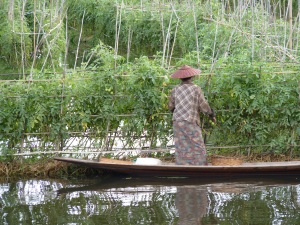 We passed other boats occasionally; mostly fishermen who swung their nets overhead and moved their wooden craft with a unique one-legged rowing method, their sinewy limb wrapped around the oar in a style not used anywhere else in the world.
We passed other boats occasionally; mostly fishermen who swung their nets overhead and moved their wooden craft with a unique one-legged rowing method, their sinewy limb wrapped around the oar in a style not used anywhere else in the world.
Inle Lake is a magical place in Myanmar (formerly Burma), where villages and monasteries rise from the water amid floating gardens, hill tribes inhabit the shoreline, and the only way to get around is by longboat. These traditional wooden boats are plied by boatmen using a unique one-leg rowing technique to transport goods and passengers, fish and go to market, all with the green, cloud-covered mountains of southern Shan State rising around the lake’s placid waters. Life in this enchanting part of Myanmar is lived the way it has been for centuries, and the people are gracious and welcoming, if a bit shy.
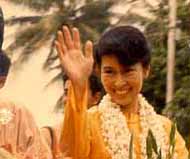
I visited Myanmar back in 2010, when Aung San Suu Kyi was still imprisoned and the country was little-visited by outsiders. There was, and still is, controversy about traveling here — an ethical debate between supporting an oppressive political regime with tourist dollars, and the benefits that those tourists bring to the everyday people living here. I personally believe that perhaps the worst thing the rest of the world can do to the people of a country living under such oppression is to completely cut them off, and so I feel that it is much more about how you travel in a place like Myanmar than if you travel here. And with “The Lady,” as Aung San Suu Kyi is known, having been released and the country recently opened to tourism, it won’t be long before this secluded and unspoiled place is under more development, so I would suggest you go sooner rather than later.
The end of this article deals with some tips to travel responsibly in Myanmar and make your travel count for the locals.
Back to Inle Lake — my favorite place in the country — don’t be deceived by the quiet, secluded aura that envelops the lake. There is plenty to see and do here, and you could easily stay occupied for several days or a week.
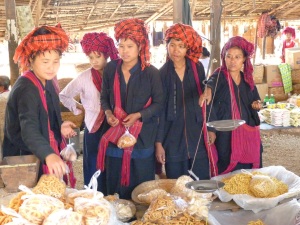
Local markets are one of the most fun attractions; check out the Ywama Floating Market, or the rotating market that moves to a different lake village spot every five days. At these markets, as well as the vendor stalls around temples and attractions, the proprietors are friendly and much less pushy than in Yangon or Bagan; it seems that the easy, laid-back nature is just a way of life here. Many of the hill tribes come down to these markets as well, with their colorful turbans and shy smiles.
Once done with shopping and eyeing local market delicacies, there are plenty of opportunities to get in touch with the soul of Myanmar. Start at interesting Nga Phe Chaung, also known as the “jumping cat” monastery. This is a small place that is home to a handful of monks, with a collection of elaborate Buddhist statues in the center of the main hall, but pretty simple otherwise.
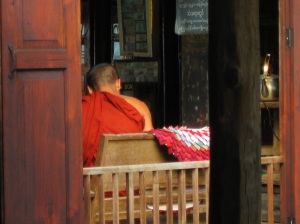
Apparently, the remote location created a lot of boredom for the monks when they weren’t studying or praying – and so to amuse themselves, they began teaching the dozens of resident cats how to jump through hoops. The monks are very friendly and forthcoming, and will easily sit down and strike up a conversation with visitors; for a small donation to the monastery, they will gladly put on their trained cat show. Also, don’t miss the temples located a short walk up the mountain from Indein Village; here you can walk amongst dozens of ancient stupas in varying states of ruin or renovation, Indiana Jones style. The Pindaya caves are also worth a visit, with their hundreds of Buddha images.
Around the lake are a number of floating gardens, where locals grow and tend to flowers and vegetables such as tomatoes, peppers and many others. The gardens make for a nice boat ride; as do the neighboring villages that are home to workshops where you can watch traditional artisans work crafts that have been handed down through generations, such as silk weaving, silver- and black-smithing, and wood carving.
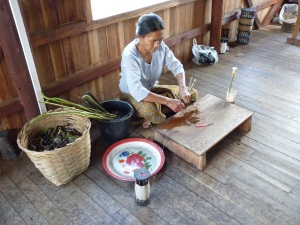
This is the only place in the world where silk is woven from an unusual source: lotus flowers. The sticky fibers inside the stem of the padonma kyar lotus are pulled out by hand and woven on wooden hand-looms to create shawls, clothing and handbags. Burmese people regard the lotus as the most sacred of flowers, and the tradition of weaving lotus silk began as a way to create monk’s robes.
A small scarf can take one to two days to make; for the full set of monk’s robes, it can take as many as 60 weavers a full 10 days to complete – and requires as many as 220,000 lotus stems to produce enough thread. Watching the process take place in a workshop such as the fourth-generation Myat Pwint Chel, in Inpawkhon Village, sitting on wooden stilts above the water while villagers boat past to the market, is like stepping back in time two hundred years. These magnificent crafts, all but lost to the outside world, are only part of the charm of Myanmar.
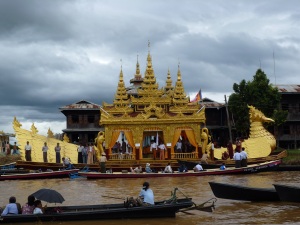
And if you’re lucky, maybe your visit will coincide with one of the many pagoda festivals of Inle Lake, a time of celebration and music when Buddha images are moved by boat from one pagoda to another. Most festivals are held between October and May.
For accommodations, I highly recommend the Shwe Inn Tha Floating Resort, situated in a secluded spot about two-thirds down the lake and perched serenely on wooden stilts just above the water. Arrival here by boat from Heho Airport or surrounding towns is like stepping back in time several hundred years.
Shwe Inn Tha was built and runs with ecological sensitivity, preserving the natural beauty and resources of the lake environment while providing a phenomenal guest experience that cannot be had anywhere else in the world. The open-air pavilion and sitting area greets you as you first arrive at Shwe Inn Tha, pulling up alongside the wooden steps in your boat. Just beyond this common area is the resort’s restaurant, a large space that serves top-notch local Tha and Shan cuisine, as well as a selection of Indian, Singaporean, European and other international dishes. Don’t miss the Shan Noodle Soup at breakfast.
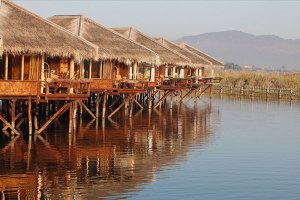
The resort also has, improbably, the only floating swimming pool I have ever encountered. The pool is filled with naturally treated and filtered water, surrounded by a large deck and comfortable lounging beds to create a refreshing afternoon retreat from sightseeing on warm days.
Each suite is an individual thatched-roof bungalow, with spacious rooms and gleaming teakwood floors and ceilings. True to the peaceful, traditional philosophy of the place, there are no televisions in the rooms and no internet connection. Mosquito nettings are provided to sleep under, and give a romantic allure to the comfortable beds even when not exactly needed for their purpose. Bathrooms are fully equipped with separate toilet room, large soaking tubs and attached private outdoor shower that is open to the sky above. Each bungalow has its own deck with chairs and a table, perfect for enjoying an evening drink while watching the spectacular sunset create an amber glow over the mountains, lake and Shwe Inn Tha.
Tips for visiting Inle Lake:
- The Shwe Inn Tha staff is excellent at making recommendations and crafting an itinerary for you — just ask.
- There is not any nightlife to speak of; you should be back at the resort before nightfall, where you can eat and have a drink but otherwise must entertain yourself. Music, reading material and card games recommended.
- While I hear reports that ATM machines are now available in Burma (there weren’t any when I visited) and more places accept credit cards, it is still advisable to bring plenty of U.S. cash to more remote places like Inle Lake.
Tips for Traveling in Myanmar:
- Bring Lots of U.S. Cash. And be sure it is newer, crisp, unmarred bills. When I was there in 2010, there were NO ATM machines and very few places accepted credit cards – even hotels and restaurants. I hear that now, there are a few ATMs and more places accept credit cards, but this is mostly in the capital city of Yangon or large businesses. I wouldn’t count on it for many things, so bringing enough U.S. cash for the trip is important.
- Book Internal Domestic Flights Once in Myanmar. For the most part, domestic Myanmar flights cannot be booked ahead of time or with a travel agent, and even if online booking could be found it is advised against due to fraud. Domestic flights are usually booked with a local travel agency once you arrive in the city of departure, from one to three days in advance. Again, cash is mostly the payment required; few travel agencies take credit cards.
- Be Extremely Conscious of Booking Independently-Owned Hotels and Using Local Guides. An important aspect of traveling to Myanmar is, and should be, the ethical debate over supporting an oppressive government versus bringing tourism dollars to local people. While this is a personal choice that must be made, and many have advised boycotting tourism to the country, in my opinion the most dangerous thing for the people of such a government is total isolation. And in my experience once there, the people are hungry for both interaction with outsiders, and the income it brings. You can make sure the majority of your money lands in the hands of locals by doing a little research. Book independent hotels instead of government-owned ones; use local guides and tour operators rather than booking packages from outside the country; and spread the wealth in each spot you visit by utilizing various drivers, vendors and artisans.
- You Won’t Be Able to Avoid Paying the Government Something. Flight taxes, departure tax, and entrance fees to some national sites and temples go to the government, and simply by visiting you cannot avoid these fees. However, as long as you keep these to the absolute minimum and stay very conscious of where your money is being spent, you can ensure that it ends up mostly in private hands, where it is needed. After visiting Myanmar, I am convinced the trade-off is worth it; every single individual I came across expressed a need for more tourists, and a desire to interact with more visitors from the outside world.
- Enjoy Interactions with Locals, and be Polite yet Firm when Refusing. As with any country where a vast percentage of the population is poor, the Burmese try to make a living any way they can and that is often through tourism. Around many of the big sites and temples you will encounter a crowd of vendors and touts, some of them quite aggressive in trying to sell you their wares. Although this can get wearying, try to remember that they would not be there if you were not there. These can actually be great spots to pick up handmade souvenirs for great prices, although the quality will not be what you’ll find in the artisan shops, so feel free to browse. However, if you don’t intend to buy then please don’t look; be firm from the outset with your “No, thank you.” Don’t browse just to be polite, with no intention of buying – let them move on to the next customer.









